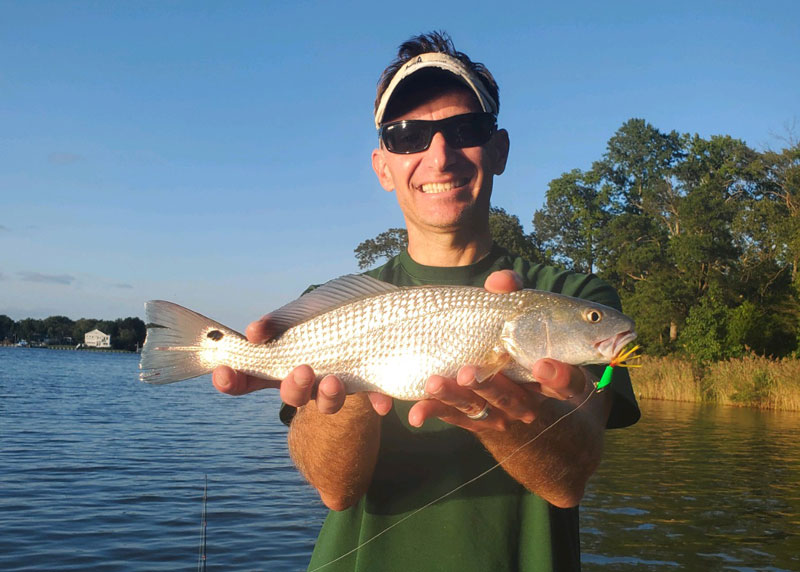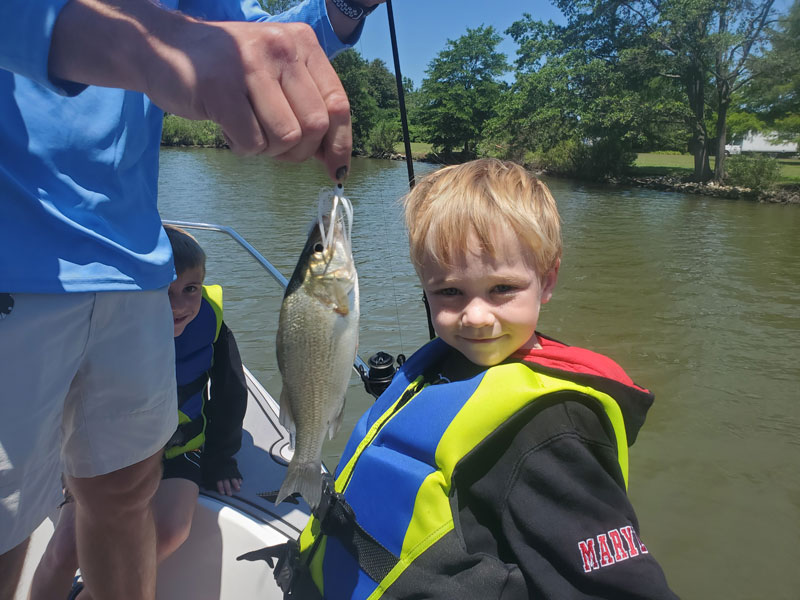Catch the biggest! Catch the most! Out-fish the other guys! Most anglers want to score big on their fishing adventures, with results like these as the goal. So we go cruising for the canyons or blasting around the Bay, putting dozens of miles under the keel and burning dozens of gallons of fuel. Have you ever asked yourself: just how many fish did I run past while going from the dock to the hotspot? Undoubtedly, the answer is a lot. Also undoubtedly, some days we’d catch more fish if we stayed within 1000 yards of where we started. Even a kayak angler has to wonder sometimes if he or she paddled past 50 fish to get to the one they’re hoping to catch. This is especially true if you’ve launched from a protected creek off of a Chesapeake Bay tributary.

From the coves of the Elk to the cover of the Elizabeth, the transitory waterways we often leave in search of fish are themselves full of fish. The species may be different and the sizes may usually (though certainly not always) be smaller, but if you overlook the opportunities provided by the tributaries you’re missing out. This is particularly true when the weather has large bodies of water riled up, and you’ll have to battle the elements if you hope to battle a fish.
Case in point: One breezy evening last summer a friend and I ran out of Ramsay Lake and into the South River, quickly decided the whitecaps were more than we wanted to deal with to catch a few schoolie rockfish, and turned right back around. Rather than return to the dock, however, we decided to enjoy a mellow evening of fishing in Ramsay itself.
This small creek off of the river is less than one mile long and a third of a mile across at its widest point, with an average depth of around six feet. From the angling perspective it doesn’t look like much. You could fish every inch of its shoreline in one afternoon, and you certainly wouldn’t think of it as a “hotspot.” Yet in three hours of fishing that evening we caught two small black drum, a small red drum, dozens of nice white perch, dozens of small croaker, and a half-dozen rockfish up to 16”. The action was nonstop, and we had a ball.
Kit for Fishing Creeks
The single biggest adjustment you need to make to be successful in these small waterways is swapping out your gear. If you cast the five-inch paddletails on the rockfish-sized rigs you have set up for the Bay you might catch a fish or two, but the bites will likely be few and far between. Instead, scale down to ultralight rigs spooled with six- or eight-pound test, topped with eight- or 10-pound leader.
The idea here isn’t to reduce gear size to match fish size so much as it is to match bait size. In these little creeks and coves the main forage base is grass shrimp and minnow, so casting anything over three inches fails to match the hatch and most offerings should be considerably smaller. Flinging these micro-baits any distance requires very light tackle, and when you luck into a big fish — it does happen from time to time even in the smallest creeks and coves — you’ll need to apply some finesse to bring it to the boat.

Top lure offerings include tube jigs on 1/8th or 1/16th ounce leadheads (just like the ones you’d fish for crappie), tiny crankbaits like the Bill Lewis Tiny Trap, and mini spinnerbaits like Perch Pounders and Super Roosters. But on many days you’ll catch more fish than all of the above combined if you tie on a shad dart and tip it with a grass shrimp. Save carp, there’s no species around that lives in creeks attached to the Bay’s brackish waters that doesn’t enjoy eating grass shrimp, and sliding one onto a shad dart cast with ultralight gear is an excellent way to present them to the fish.
One more item to make sure you have: a landing net. Twenty-inchers will show up from time to time and with lines, rods, and hooks so diminutive, trying to swing up a relatively large fish usually results in a break-off or pulled hook.
Hotspots Galore
Working shorelines is usually the best approach in a creek, and you probably know what to look for already: docks, riprap, and deadfall. All of these forms of structure can hold fish, but in most bodies of water like these the fish will be concentrated at just a few standout hotspots. And in many areas you’ll be presented with dozens of docks and items to cast for. How will you know which to target? Over time you’ll figure out which specific ones the fish gravitate towards, but when hitting a new area for the first few times make it a point to stay on the move. If there are 10 piers along a section of shoreline don’t take more than two or three bite-less casts at any one before moving on. If there’s a long stretch of riprap don’t try to work each and every rock, instead try moving at least 10 or 15 yards between casts. Only when you hook up a fish should you pause and work the area for a bit.
Spend an afternoon fishing ultralight gear in a quiet creek or cove, and you’ll likely discover that all the times you ran out of it you’ve been running away from fish. A lot of fish.
BONUS TIP: Creeks and coves heat up more than open waterways and can get uncomfortably warm for the fish. They’ll seek out shade, so you should, too. Overhanging trees, boathouses, and docks all create shade and often you’ll find fish hiding in it, especially when there’s a strong afternoon sun with no cloud cover.